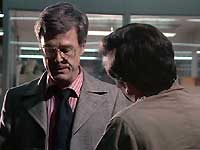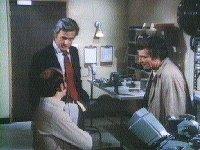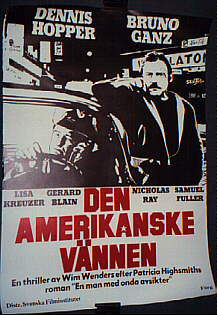August 03, 2006
The detective supposed to know
 |  |
Bacteria grl makes her very welcome entry into the blogosphere, and responds to my post on Columbo and Ripley by raising the issue of the distinctive narrative structure of the Columbo series, in which 'the preparation and the murderer and the murder itself is always showed first, in many cases it is shown along with the opening credits, and often in a quite lurid style ... or if not lurid, in a fairly telescoped visual shorthand that displays all the elements of the crime with no dialogue or music, total silence with quick cuts.'
Columbo departs from the technique of 'reconstruction' upon which the Dupin/ Holmes mode of detective fiction was built. In The Mechanical Bride, McLuhan compares the sleuth of the Dupin/Holmes mode with the cinematographic apparatus itself:
- Edgar Allan Poe hit upon the principle of "reconstruction," or reasoning backwards, and made of it the basic technique of crime fiction and symbolist poetry alike. Instead of developing a narrative straightforward, inventing scenes, character, and description as he proceeds, in the Walter Scott manner, Poe said: "I prefer commencing with the consideration of an effect."
... The sleuth pursues his clues backward to the cause which produced them. He investigates the possible motive of each suspect. Then he assembles all these different perspectives as though he were piecing together a movie that had been shot in separate sections. When all is assembled, he then projects, as it were, the continuous film before the assembled guests at the scene of the murder. He relates the events in their true time sequence, thus automatically revealing the murderer.
It was Poe who discovered the technique of this intellectual cinematograph half a century before the movie camera was invented.
It's worth noting that the departure from this reconstructive technique is something else that Columbo has in common with Highsmith (and with their common ur-source, Crime and Punishment). Highsmith, too, completely abandons the whodunnit structure. Her novels are usually focalized through the subjectivity of the murderer, leaving us no option but to identify with him.
I think the effect of our seeing the murder first in the Columbo episodes is similar, in that we identify with the murderer, not with the detective.
Columbo is not like Dupin or Holmes, a 'gentleman aesthete' existing in his own lifeworld before being called in to solve a crime. Nor is he like Poirot, a bystander in the midst of an aristocratic revel asked to decide which of the his fellow leisure class hedonists is the murderer. Columbo exists only after the crime has been committed, almost as if he is a pure apparition of guilt. The model is the Poe, not of the Dupin stories, but of 'The Tell Tale Heart'. From the guilt-ridden perspective of the murderer, Columbo is not so much the one who knows as the one who must know.
In the classic 70s episodes, Columbo is rarely seen on his own. We typically do not see Columbo 'for himself', only for the criminal, leaving the possibility that the entire Columbo persona - his shambling manner, his absent mindedness, even his references to his wife - may all be a performance designed to disarm the murderer. Unlike middlebrow bores such as the insufferable Morse, Columbo is not 'a man of taste'; he has no psychological depth.
This lack of psychological depth, his reduction to pure function, make Columbo like the pyschoanalyst, i.e. the one in the structural position of one supposed to know. Columbo's deliberately irritating questioning technique - 'just one more thing' - is designed to produce discomfort rather than to elicit information. (The first mistake that the murderer makes is always to airily explain away some anomalous fact with which Columbo presents them. The murderer's flip readiness with an explanation, their willingness to implicate others, already constitutes a kind of admission of guilt. You always feel that they would be far better to simply scratch their heads and express bewilderement.) The plots usually turn on Columbo inducing the murderer to repeat (some aspect of) the crime, i.e. to confront the trauma they are seeking to escape. Like the successful analysand, they must retrospectively take responsibility for what happened: where It (the trauma-murder) was, there I shall be.
________________________________________________________________

Owen interestingly observes that a link between Columbo and Ripley is made in the films of Wim Wenders. Wenders' Wings of Desire features what is evidently a version of the Columbo character, whereas The American Friend is a somewhat loose adaptation of Ripley's Game. If both the Columbo series and the Ripley novels were American versions of European existential narratives, then Wenders' early films represented a complementary European fascination with the USA, America's rootlessness functioning both as an analogue for, and a solution to, West Germany's necessary postwar cultural amnesia.
If Wenders' humanism prevented him from capturing Ripley, it also caused him to miss Columbo. By showing 'Columbo tucking into currywurst at a Kreuzberg imbiss', Wenders precisely gives Columbo depth and an independent subjective life (some of the later Columbo episodes make the same mistake, and we see Columbo eating chili in restaurants etc). The 'angelic' side of Columbo does not consist in his 'really being a regular guy'; it is inseparable from his implacablity, his role as a psychological torturer.
(Wings of Desire has always struck me as appalling sentimentalized: like the 'Everybody Hurts' video, or one of those commercials which show that we might have different hopes and dreams but hey, we're all people, right? Kind of Epic Trite; no wonder he'd soon be working with U2.)
Posted by mark at August 3, 2006 01:25 AM | TrackBack